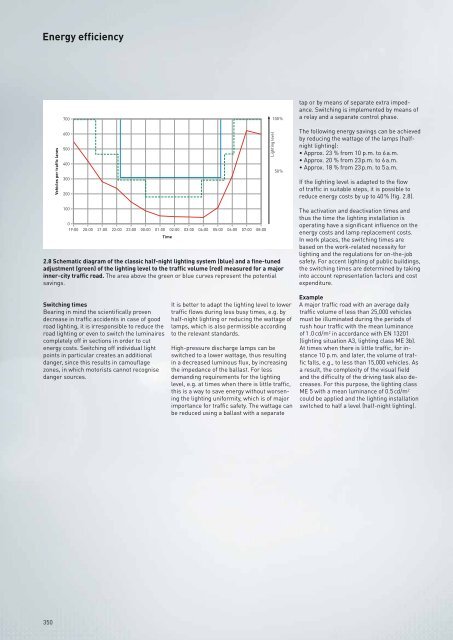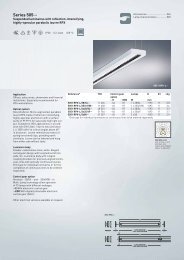- Page 1:
Outdoor Luminaires for exterior are
- Page 4 and 5:
We expend a majority of our energy
- Page 6 and 7:
180 LS 244 Lichtlinie 190 Laterne 2
- Page 8 and 9:
6 TRILUX Luminaires - Decoratively
- Page 10 and 11:
8 TRILUX Luminaires - Technical App
- Page 12 and 13:
10 TRILUX Spotlights and floodlight
- Page 14 and 15:
12 DZ luminaires - decorative Appli
- Page 16 and 17:
14 DZ luminaires - decorative Appli
- Page 18 and 19:
LUMINAIRES ATTENTION AND AT ATTEN D
- Page 20 and 21:
88··· 98··· 052 984··· ser
- Page 22 and 23:
Decorative luminaires that go far b
- Page 24 and 25:
The best way to deal with diverse t
- Page 26 and 27:
Luminaires that not only illuminate
- Page 28 and 29:
Standards and aesthetics do not nee
- Page 30 and 31:
28 88··· series During the day,
- Page 32 and 33:
880··· series Pathway Luminaires
- Page 34 and 35:
881··· series Pathway Luminaires
- Page 36 and 37:
882··· series Pathway Luminaires
- Page 38 and 39:
883··· series Pathway Luminaires
- Page 40 and 41:
883··· series Pillars 65M IP65 P
- Page 42 and 43:
40 98··· series Thanks to its mo
- Page 44 and 45:
98··· series Easy mounting and m
- Page 46 and 47:
980··· series Cylindrical Lumina
- Page 48 and 49:
981··· series Lanterns 65M 46 ·
- Page 50 and 51:
982··· series Indirect Lanterns
- Page 52 and 53:
983··· series Conical Lanterns 6
- Page 54 and 55:
984··· series Spherical Lanterns
- Page 56 and 57:
985··· series Classic Lanterns 6
- Page 58 and 59:
986··· series Classic Conical La
- Page 60 and 61:
98··· series Accessories 58 A 09
- Page 62 and 63:
60 988··· Secondary Reflector Lu
- Page 64 and 65:
62 Saterna Its appearance stands ou
- Page 66 and 67:
Saterna 961··· Post-top Luminair
- Page 68 and 69:
931··· series Side-bracket-mount
- Page 70 and 71:
7-107··· series Rodalux K 65a IP
- Page 72 and 73:
70 908··· series The decorative
- Page 74 and 75:
LUMINAIRES RELIABLE AS T HE THAT N
- Page 76 and 77:
Lumega 080 971··· series Lumega
- Page 78 and 79:
Perfect exterior lighting can be fe
- Page 80 and 81:
Outstanding security, distinguished
- Page 82 and 83:
80 Lumega 700/900 The functional lu
- Page 84 and 85:
Lumega 700/900 82 The Lumega optics
- Page 86 and 87:
Lumega 700/900 Installation and mai
- Page 88 and 89:
Lumega 700 Post-top and bracket-mou
- Page 90 and 91:
Lumega 900 Post-top and bracket-mou
- Page 92 and 93:
Lumega 700/900 Accessories 90 Pole
- Page 94 and 95:
Lumega 700/900 Accessories Reductio
- Page 96 and 97:
When illuminating parking areas, lo
- Page 98 and 99:
932··· series Post-top luminaire
- Page 100 and 101:
935··· series Post-top luminaire
- Page 102 and 103:
936··· series Post-top luminaire
- Page 104 and 105:
102 933···, 934··· series The
- Page 106 and 107:
933···, 934··· series Post-to
- Page 108 and 109:
979··· series Bracket-mounted lu
- Page 110 and 111:
108 877··· series The 877···
- Page 112 and 113:
THE BEST T THE DA IS THAT IT HELPS
- Page 114 and 115:
Lumena 122 863··· series Lumena
- Page 116 and 117:
Light for everything that should be
- Page 118 and 119:
Exceptional illumination of archite
- Page 120 and 121:
High performance that you can see -
- Page 122 and 123:
Focusing on sports and historic hig
- Page 124 and 125:
122 Lumena 150···
- Page 126 and 127:
Lumena 150 Compact Spotlight 65a IP
- Page 128 and 129:
Lumena 150 Compact spotlight with b
- Page 130 and 131:
Lumena 150 Accessories 128 0863ES 0
- Page 132 and 133:
130 Lumena 400 and 600 Floodlights
- Page 134 and 135:
Lumena 400/600 Floodlights for acce
- Page 136 and 137:
Lumena 400/600 Floodlights for stre
- Page 138 and 139:
Lumena 400/600 Floodlights for stre
- Page 140 and 141:
Lumena 400/600 Floodlights for stre
- Page 142 and 143:
Lumena 400 Floodlight for accentuat
- Page 144 and 145:
Lumena 600 Floodlight for accentuat
- Page 146 and 147:
Lumena 400/600 Accessories 144 Refe
- Page 148 and 149:
146 Estadia The TRILUX Estadia is a
- Page 150 and 151:
Estadia Wide beam floodlight 65a IP
- Page 152 and 153:
Estadia System Accessories Shield m
- Page 154 and 155:
152 Maxilux Good light is an essent
- Page 156 and 157:
Maxilux Compact Floodlight 65a IP65
- Page 158 and 159:
Optilux Linear Floodlight 65a IP54
- Page 160 and 161:
DURING THE A DECORATIV AT NI A DECO
- Page 162 and 163:
180 LS 190 Laterne 192 RL 200 SR 20
- Page 164 and 165:
248 Elle 254 Lionda 258 Ondo 266 Un
- Page 166 and 167:
When outdoor lighting needs to achi
- Page 168 and 169:
Highlights of the town: the DZ LS,
- Page 170 and 171:
For us, outdoor lighting is always
- Page 172 and 173:
170
- Page 174 and 175:
172
- Page 176 and 177:
Can you walk over light? The DZ Lic
- Page 178 and 179:
Burning for architecture: the DZ Li
- Page 180 and 181:
Set uniquely inimitable accents. Wi
- Page 182 and 183:
Design: Peter Zegers 180 LS
- Page 184 and 185:
LS Decorative light columns with sq
- Page 186 and 187:
LS Decorative bollard and wall lumi
- Page 188 and 189:
LS Decorative light columns with tr
- Page 190 and 191:
LS Decorative bollard and wall lumi
- Page 192 and 193:
Design: Peter Zegers Distinguished
- Page 194 and 195:
192 RL Design: Peter Zegers For all
- Page 196 and 197:
RL 730/400 Decorative light pillars
- Page 198 and 199:
RL 350/120/W Decorative light colum
- Page 200 and 201:
RL 500/450/280 Decorative light col
- Page 202 and 203:
200 SR Design: Peter Zegers Conspic
- Page 204 and 205:
SR Decorative light columns, bollar
- Page 206 and 207:
Design: Foster and Partners 204 Foc
- Page 208 and 209:
Focus Decorative light columns and
- Page 210 and 211:
Focus Decorative bollard luminaires
- Page 212 and 213:
Design: Christian von Stackelberg 2
- Page 214 and 215:
Design: Wilmotte et Associés 212 B
- Page 216 and 217:
Design: Klaus Begasse 214 Reeds Gar
- Page 218 and 219:
Reeds I Decorative light objects M
- Page 220 and 221:
Reeds II Decorative light objects M
- Page 222 and 223:
Design: Peter Zegers 220 HS Simple,
- Page 224 and 225:
HS Decorative bollard and wall lumi
- Page 226 and 227:
Design: Ernesto Gismondi 224 Zauber
- Page 228 and 229:
Zauberflöte Decorative high bollar
- Page 230 and 231:
Zauberflöte Decorative light colum
- Page 232 and 233:
Zauberflöte Decorative ceiling sur
- Page 234 and 235:
Design: Peter Zegers 232 DI Direct-
- Page 236 and 237:
Design: Peter Zegers 234 Segmentkug
- Page 238 and 239:
Design: Peter Zegers 236 Varisto Si
- Page 240 and 241:
Design: Peter Zegers 238 DKS Flexib
- Page 242 and 243:
Design: Peter Zegers 240 Lichtboden
- Page 244 and 245:
Lichtboden Decorative ground recess
- Page 246 and 247:
Design: Peter Zegers 244 Lichtlinie
- Page 248 and 249:
Lichtlinie Decorative ground recess
- Page 250 and 251:
Design: Klaus Begasse 248 Elle The
- Page 252 and 253:
Elle Decorative post-top luminaires
- Page 254 and 255:
Elle Decorative bollard and wall lu
- Page 256 and 257:
254 Lionda Design: David Chipperfie
- Page 258 and 259:
Lionda Decorative post-top and boll
- Page 260 and 261:
258 Ondo Design: SSP Schmitz Schimi
- Page 262 and 263:
Design: Peter Zegers 260 Symbol A l
- Page 264 and 265:
Symbol I Decorative post-top and wa
- Page 266 and 267:
Symbol II Decorative post-top lumin
- Page 268 and 269:
Design: Peter Zegers 266 Uni Consis
- Page 270 and 271:
Uni Decorative post-top and bracket
- Page 272 and 273:
Uni 120 Decorative bollard luminair
- Page 274 and 275:
Uni Decorative luminaire with yoke
- Page 276 and 277:
Uni Decorative luminaires with yoke
- Page 278 and 279:
Uni Decorative wall luminaires, rec
- Page 280 and 281:
Design: Klaus Begasse 278 Sonnos Li
- Page 282 and 283:
Sonnos Decorative bracket arm lumin
- Page 284 and 285:
Sonnos Decorative suspension or wal
- Page 286 and 287:
Design: Klaus Begasse 284 Pinzetta
- Page 288 and 289:
Pinzetta Decorative bracket arm lum
- Page 290 and 291:
Design: Peter Zegers 288 Ontria
- Page 292 and 293:
Ontria Decorative post-top and wall
- Page 294 and 295:
Design: Peter Zegers 292 Tube Orien
- Page 296 and 297:
Tube Decorative post-top and wall l
- Page 298 and 299:
296 VR Design: Peter Zegers Perfect
- Page 300 and 301:
Design: Marcus Botsch 298 Potsdam I
- Page 302 and 303: 300 Palme Design: Michele de Lucchi
- Page 304 and 305: Palme Decorative post-top luminaire
- Page 306 and 307: Palme Decorative bollard and wall l
- Page 308 and 309: Design: Italo Rota, Alessandro Pedr
- Page 310 and 311: Emporium Decorative post-top, bolla
- Page 312 and 313: Emporium Decorative post-top lumina
- Page 314 and 315: Design: Pearson & Lloyd Award: FX A
- Page 316 and 317: Westminster Decorative bracket-moun
- Page 318 and 319: Westminster Decorative post-top lum
- Page 320 and 321: Westminster site amenities Site ame
- Page 322 and 323: THERE ARE MANY DET LIGHT SO V UNCOM
- Page 324 and 325: Photometrics 322 IS IRL GB NL D B L
- Page 326 and 327: Photometrics Light for Europe With
- Page 328 and 329: Photometrics Criteria for good outd
- Page 330 and 331: Photometrics Criteria for good outd
- Page 332 and 333: Photometrics Criteria for good outd
- Page 334 and 335: Photometrics Criteria of good outdo
- Page 336 and 337: Photometrics Road lighting Lighting
- Page 338 and 339: Photometrics Pedestrian crossings P
- Page 340 and 341: Photometrics Work places Lighting o
- Page 342 and 343: Photometrics Sports facilities Spor
- Page 344 and 345: Photometrics Accent lighting Buildi
- Page 346 and 347: Photometrics Light + Ecology The ec
- Page 348 and 349: Energy efficiency Decision-makers f
- Page 350 and 351: Energy efficiency Refurbishment nee
- Page 354 and 355: Electrical technology Planning aid
- Page 356 and 357: Electrical technology Planning aid
- Page 358 and 359: Electrical technology Switching ill
- Page 360 and 361: Operating conditions and symbols TR
- Page 362 and 363: Lamp characteristics P L P Sys ** L
- Page 364 and 365: Lamp characteristics P L P Sys ** L
- Page 366 and 367: Lamp characteristics P L P Sys ** L
- Page 368 and 369: Product index Reference Page 7-107
- Page 370: TRILUX GmbH & Co. KG Heidestraße



